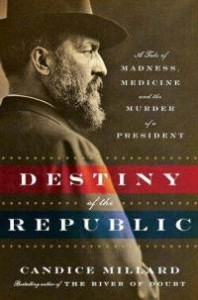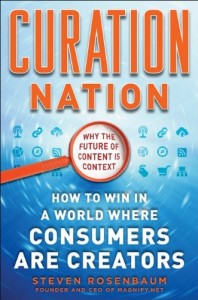Notes on two books I’ve read recently:
 Destiny of the Republic:
Destiny of the Republic:
A Tale of Madness, Medicine and the Murder of a President
Candice Millard
Doubleday, 2011
My Rating: *****
Remember our 20th president – James A. Garfield? Chances are, you probably don’t, which is why the new history Destiny of the Republic is so informative (and fascinating!). Garfield rose above the circumstances of his birth and family pedigree to become a scholar, hero of the Civil War, and popular congressman. In 1880, as the United States was still grappling with the divisions left in the wake of the Civil War, Garfield was nominated for president against his will. Four months after he won the election, a deranged man stalked Garfield for weeks and then shot him in the back.
Amazingly enough, the shot didn’t kill Garfield. In fact, had the president been treated the way many Civil War soldiers had been treated, Garfield would probably have survived and made a full recovery. Instead, a group of physicians (including Lincoln’s doctor from the night he died) botched Garfield’s treatment by dismissing powerful new evidence regarding the need for sterilization before surgery. A lunatic shot Garfield. But medical lunacy killed him. For more than two months, Garfield’s health deteriorated until he finally succumbed to massive infection.
Candice Millard’s historical account of this turbulent time in American history is one of the best popular history books I’ve ever read. Not only did I finish it feeling like I knew James Garfield, I also enjoyed the thrilling pace of the plot development. We follow assassin Charles Guiteau as he stalks the president. We watch Alexander Graham Bell, who had recently invented the telephone, work feverishly day and night on his metal-detecting invention. We see the White House staff invent the first air conditioner in order to keep the president cool during his convalescence in the White House. We are privy to letters and historical documents that reveal the doctors’ medical debates regarding Garfield’s care. And we watch a still-fractured country unite around their wounded commander-in-chief.
(Interesting tidbit: In the train station with Garfield when he was shot was Robert Todd Lincoln, Abraham Lincoln’s oldest son. Twenty years later, he was in Buffalo, NY when William McKinley was assassinated.)
 Curation Nation:
Curation Nation:
How to Win in a World Where Consumers Are Creators
Steven Rosenbaum
McGraw Hill, 2011
My Rating: ***
Anyone can start a blog or Web site today. But finding good blogs and important information can be difficult. Like looking for a needle in a haystack, Internet users are beginning to share their findings with others through blogs, Facebook, and Twitter. In the words of author Steven Rosenbaum:
“We’re becoming a Curation Nation, a place where abundance is assumed in the world of content. There’s no shortage of content makers of all shapes and sizes. But the avalanche of content makes finding the content you’re looking for significantly harder. Accidental curation is passive, anonymous endorsement. It’s curation for the crowds.”
What’s the difference between content creation and content curation? “Curation is about selection, organization, presentation, and evolution. While computers can aggregate content, information, or any shape or size of data, aggregation without curation is just a big pile of stuff that seems related but lacks a qualitative organization.” That’s why we need the human element. Rosenbaum believes that the “tsunami of data” makes human curation more important than computerized curation.
Curation is nothing new. Reader’s Digest perfected the magazine version decades ago. The Huffington Post and Time magazine are also good examples of curation. So how should businesses respond to the rise of a “curation nation”? Rosenbaum encourages people to embrace the new order:
“The idea that you can go back to a pre-Internet world where you can create walled gardens around content, and charge for admission, is simply futile. Those who try that are going to fail.”
Curation Nation is an intriguing book about the need for editors. Rosenbaum sees a need for people who can organize material into a coherent way of seeing the world. Of special interest to me was Rosenbaum’s emphasis on curiosity, something I have written about recently.
“What are the key traits that can make you successful in the new world that’s emerging? Scott Kurnit, who founded About.com, says it’s about curiosity. He says when he hires people he asks: ‘How do I figure out whether this person is curious or not? ‘Cause if they’re curious they’ll look around the corners, and then the trick is to make sure that they … that they either don’t look too far around that corner or that they don’t stick their head out … I think about when I stick my head out on Lexington Avenue, where this car is gonna whiz by … so, you know I guess it’s curiosity with careful, carefultude.’ Careful curiosity—is that you?”

















